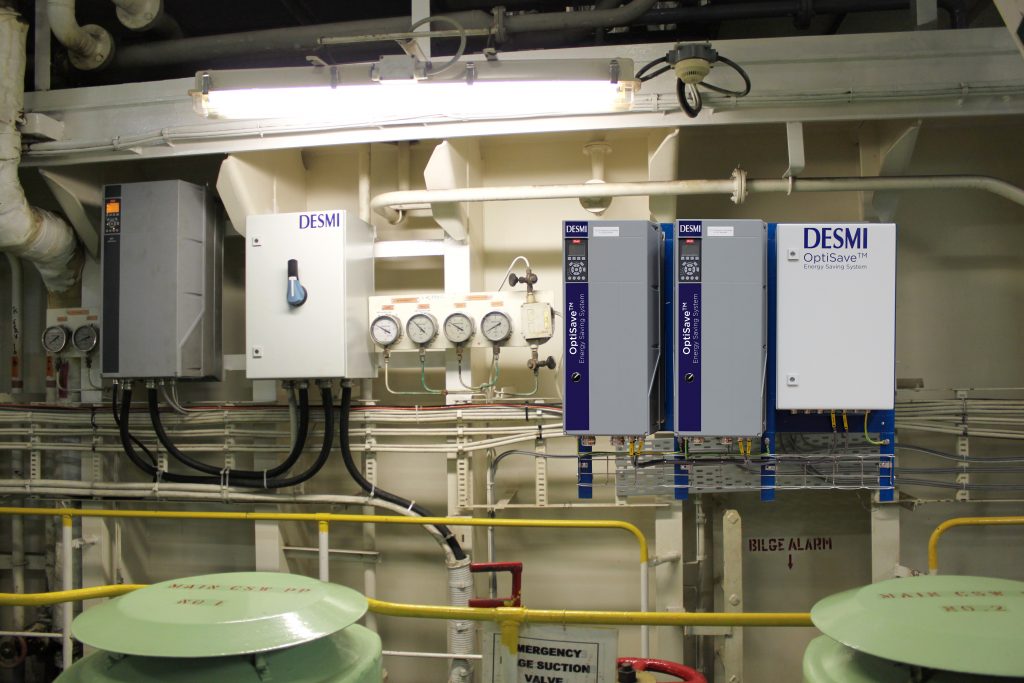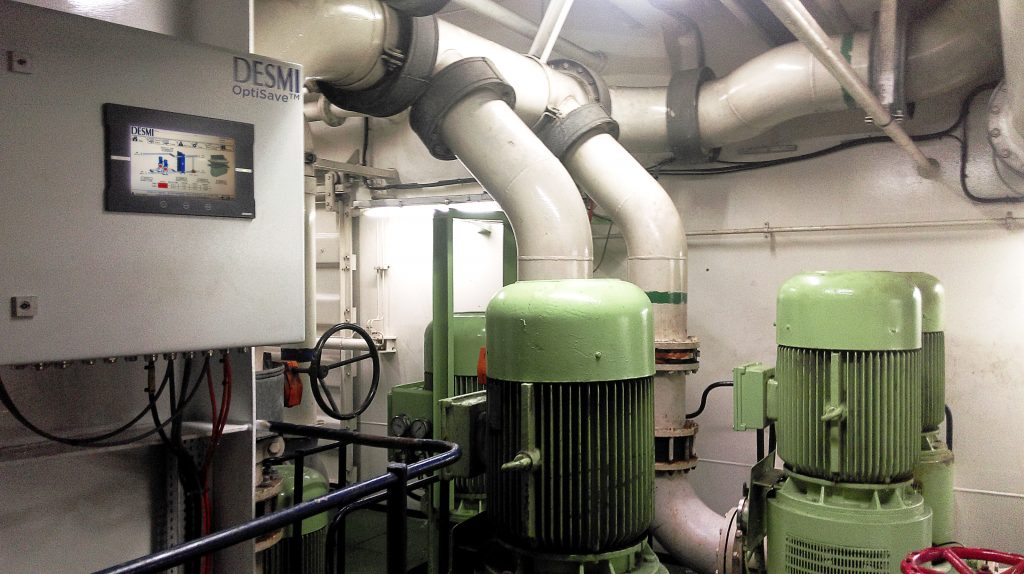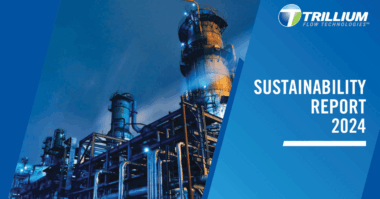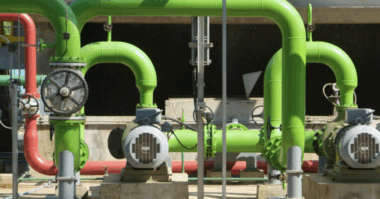Maritime pumping solution manufacturer DESMI’s energy-optimization approach generates positive cash flow for ship-owners struggling to comply with new regulations.
New rules call for fresh approach
It’s hardly news that the shipping industry is mobilizing to meet the demands of wave after wave of new environmental regulations. From the IMO’s ballast water management legislation to EEDI (the Energy Efficiency Design Index for new ships) and SEEMP (Ship Energy Efficiency Management Plan), ship-owners need to be ready to drastically cut energy consumption and emissions.
Vessel and equipment producers have, of course, risen to the challenge, devising tools and strategies from new, energy-saving hull paints to higher-capacity container ships. But is there a way to make the necessary investments to satisfy regulations and create savings, too?
Pump solution manufacturer DESMI, drawing upon its long track record in the development and manufacture of pump solutions for marine, industry, oil spill, defense and energy industries, has the answer to that question.
DESMI is focused on reducing energy consumed by onboard equipment in and around engine rooms. With solutions covering everything from seawater pumps to ventilation systems, the company has found plenty of ways to cut consumption costs. Its solutions have surprisingly short payback times – but often, the most compelling aspect is the annual savings that follow. And the company is putting forward solid customer data to prove its claims.
Optimizing onboard energy
Auxiliary systems in engine rooms and their pump components are designed to cope with the worst possible foreseeable conditions. In reality, however, such systems can be made to run at operating levels that better correspond to the vessel’s actual load at any particular time. And according to DESMI’s Michael Lassen, Segment Director for Marine & Offshore, this is an excellent strategy for ship-owners keen to comply with the new regulations.
“A lot of onboard machinery constantly operates as though the vessel is under 100 percent load and having to cope with air temperatures of up to 50 degrees Celsius and sea water temperatures up to 32 degree Celsius. But those conditions reflect perhaps only one percent of a ship’s operating lifetime. The rest of the time, you might say, it’s like running the heating in your house at full blast with the windows wide open. Making control systems that closely match energy consumption to actual requirements is something we’ve been focusing on for a number of years.”
Saving on pumping power
As a starting point, DESMI’s own seawater pumps are designed to pull maximum efficiency out of today’s pumping technologies. But the company doesn’t stop there, extending its energy efficiency range to optimization solutions such as DESMI OptiSave™ which can, for example, save up to 80 percent of power consumption for a vessel’s seawater pumping tasks.
“We have delivered many of these solutions by now,” says Michael Lassen. “And all have been shown to provide 60-80 percent savings for ships travelling, for example, between ports in Europe and Asia.”
Seawater pumping systems aren’t the only pumps in a vessel’s engine room. Other systems cool down steam that hasn’t been used in steam turbines, for example, condensing vapor into liquid again before re-feeding it into the boiler. When there is little steam to be returned to the condenser, less seawater is required, enabling the speed of the pump to be reduced to a necessary minimum.
Another area for potential savings arises, for example, when the vessel is sailing at lower speeds. Normally, 3-4 fans push compressed air into the engine room to boost combustion effect. These systems usually run at full speed, regardless of load, even when less air is required. DESMI’s OptiSave™ controls these components, too, reducing their speed to correspond to real needs.
DESMI also applies similar thinking to the sulphur-removing scrubber systems required for vessels operating in Nordic SECA (Sulphur Emission Control Area) zones. Such systems use a ‘rain shower’ of water to clean the gas produced by heavy fuel oil, removing sulphur and other undesirables before releasing the exhaust into the atmosphere. Highly resistant, stainless-steel pumps provide the seawater for this process and, with the scrubber system placed at the highest point on the vessel, they typically consume considerable energy.
All-in-one optimization
A key advantage of DESMI’s Optisave™ is the ability to install just one piece of extra onboard equipment to control the energy for seawater, condenser and engine room fans. With just one cabinet, ship designers can easily incorporate new energy savings without significantly adding to the deck space headaches already caused by the need to install additional systems for environmental compliance.
 Positive cash flow
Positive cash flow
So why is all this onboard energy saving a good deal for the already cramped budgets of today’s ship-owners? Michael Lassen claims that, apart from the benefits of sheer regulatory compliance and continued access to profitable sailing routes, the potential savings of onboard energy control systems have proven to be quite spectacular.
“While it may be tempting to let tight new-build budgets dominate onboard equipment specifications, ship-owners can do themselves a favor by focusing on the medium and longer term numbers behind high-end pumps combined with energy-optimizing systems like OptiSave™.”
“Fuel is the most expensive component of the maritime business model. So once such a system is installed, it’s quick to prove its worth. And with the initial investment recouped, the ship-owner actually earns money every single year until the vessel is decommissioned, sold or scrapped.”
DESMI has plenty of data to prove its claims. The company’s off-the-shelf optimization systems achieve a six-month payback time for new buildings, which is blindingly fast for most engine room additions. Turnkey systems, such as those recently sold to one of the world’s top three container lines, achieve their payback in around 18 months. After that period, savings of $40,000 annually per vessel are achieved. These particular systems were retrofitted on vessels in operation, and DESMI was responsible for project handling, installation and commissioning, all for a fixed price.
”With annual gains like these, even the current oil price slide isn’t affecting the general business case – or our sales of new systems. And everybody knows that the oil price will not stay this low forever,” says Michael Lassen.
Balancing the books
Energy-optimizing systems also help to make sure ship-owner business models don’t suffer from the additional fuel consumption associated with ballast water treatment systems and other new, mandatory equipment. Here, optimization power-savings can balance the fuel equation to maintain vessel profitability.
The strongest argument for DESMI’s green ship solutions is to be found in the data it has made publicly available at www.optisave.info – and in the specific calculations its energy experts can carry out for interested ship-owners and their vessel designers. But according to Michael Lassen, there’s still more work that can be done to squeeze further savings out of today’s auxiliary systems on board vessels.
“The new energy efficiency index regulations are pushing us to develop even higher-efficiency pumps. We are still trying to lift up from 80 to 85 percent efficiency, challenging ourselves to do better because we know that these pumps run around the clock – so even a five percent improvement can make a very worthwhile difference over time.“
 Pumps For Free
Pumps For Free
DESMI offers a wide range of energy-saving products under it’s ‘Pump-for-free’ program, which enables ship-owners to energy-optimize their vessels with an ROI under 2 years. Click here to Learn more.
If you have any questions about this article or need more information, please do not hesitate to contact us at desmi@desmi.com or call (757) 857-7041. Visit us at www.desmi.com to learn more about our marine and offshore solutions.




